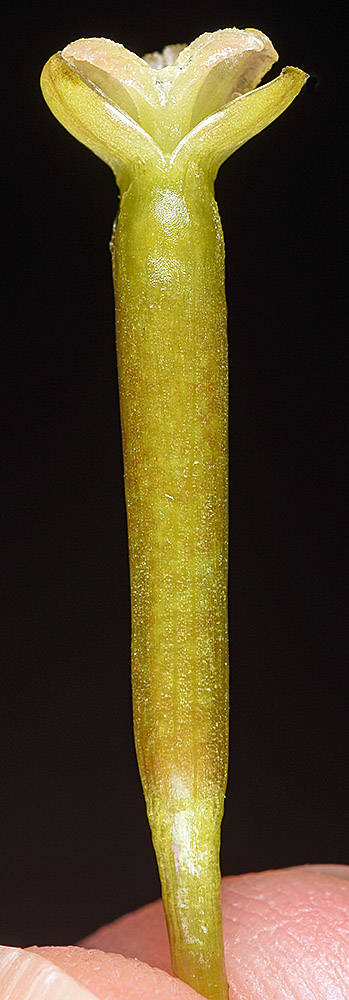
Plants herbs; rhizomes and stolons present.
Stems unbranched.
Leaves 10–75(150) × (0.1)0.3–1.5 cm; blades linear, thin, flat, ribbon-like, lighter colored in middle, apex obtuse to slender pointed, midveins of 8–10 rows.
Inflorescences long-pedunculate; bracts present.
Flowers sepals 3, unequal, 1 smaller than others; petals 3, linear, white to transparent.
Staminate flowers stamens (1)2(3), filaments distinct, floating to surface, anthers round.
Pistillate flowers stigmas 2–3-lobed, style 1.
Fruits cylindric to elliptical, ridged, 5–10 cm long, dehiscence irregular.
Seeds elliptical, glabrous.
2n=20.
Fresh to brackish rivers, streams, lakes, ponds, and bays. Flowering Jul–Sep. 0–50 m. Est. CA, ID, NV, WA; north to British Columbia, south to northern South America; From Manitoba and Nova Scotia south to FL; Africa, Australia, Eurasia. Native.
as described under Vallisneria americana
Scapes: staminate scapes 30--50 mm, submersed; pistillate scapes elongate, projecting flowers to surface. Leaves 10--110 ´ 0.3--1.5 cm; leaf blade 3-zoned longitudinally, margins entire to serrate. Flowers: staminate flowers 1--1.5 mm wide; stamens 2, filaments basally connate; pistillate flowers solitary, rarely in umbel-like clusters. 2n = 20.Flowering summer--fall. Fresh to brackish waters of streams, lakes, rivers, and bays; 0--500 m; Man., N.B., N.S., Ont., Que.; Ala., Conn., Del., D.C., Fla., Ga., Ill., Ind., Iowa, Ky., La., Maine, Md., Mass., Mich., Minn., Miss., Mo., Nebr., Nev., N.H., N.J., N.Y., N.C., Ohio, Oreg., Pa., R.I., S.C., S.Dak., Tenn., Tex., Vt., Va., Wash., W.Va., Wis.; Mexico; West Indies; Central America; Asia.Vallisneria americana plus various species of Sagittaria, Sparganium, and Blyxa aubertii form usually sterile basal rosettes of long, linear leaves in shallow water in North America. Vallisneria can easily be separated from the others by the following combination of char acter states: base of leaves nearly flat in cross section, broad band of lacunae along each side of midvein, roots without cross septa, and absence of milky juice. The three other genera have a different combinations for these characters.Vallisneria spiralis Linnaeus has been reported in some of the older literature as being represented in North America. These reports are all based on a misapplication of the name V. spiralis and are actually V. americana. In warmer waters of southeastern United States are some populations of Vallisneria with much larger leaves that have been given the name V. neotropicalis. After considerable study of populations in the field, the plants formerly known as V. neotropicalis were determined to be just larger individuals of V. americana (R. M. Lowden 1982).